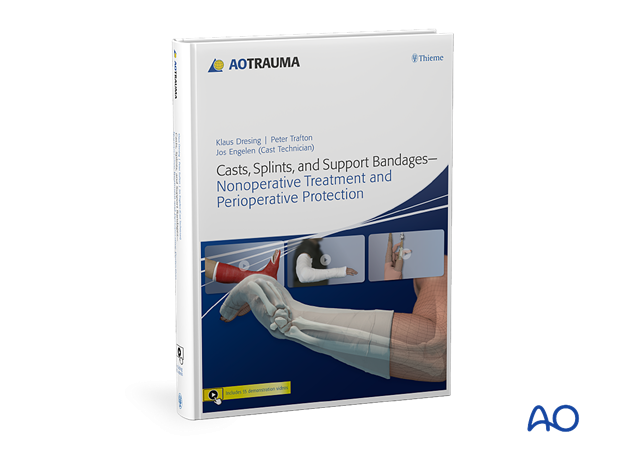Casting of upper limb for pediatric fractures
1. General introduction to nonoperative fracture care
Klaus Dresing and Jos Engelen are presenting a live interactive Webcast.
Learning goals
- Describe the characteristics of the different casting materials.
- Explain the principles of cast application.
- Define the basic steps of post application treatment.
- Recognize potential for and prevent complications.
- Apply casts and splints and prescribe orthoses.
2. Videos from "Casts, Splints, and Support Bandages—Nonoperative Treatment and Perioperative Protection"
Introduction
The below videos are taken from the AO Publication "Casts, Splints, and Support Bandages - Nonoperative treatment and perioperative protection" edited by Klaus Dresing, Peter Trafton, and Jos Engelen. This publication examines the principles, methods, and techniques for applying a modern plaster or synthetic cast for the treatment of fractures, ligament, nerve, and soft-tissue injuries, overload injuries, and infections. It includes access to 55 cast and splint demonstrations on high-quality online video.
The book can be purchased both as a hard copy and as a E-Book.

Clavicle support bandage
Support bandageIndications
- Fracture of the clavicle
Goal
- Stabilization of the forearm and elbow
Gilchrist bandage
Support bandageIndications
- Fracture of the proximal humerus
- Shoulder injuries
Goal
- Stabilization of the proximal humerus and the shoulder
Collar and cuff bandage
Support bandageIndications
- Fracture of the supracondylar humerus in children
- Temporary immobilization in proximal diaphyseal humeral fractures and shoulder injuries in adults
Goal
- Elbow in flexion to maintain position, depending on the extent of swelling
Sarmiento humeral brace
Synthetic, combicast techniqueIndications
- Diaphyseal fractures of the humerus
- Not recommended for primary fracture care
Goal
- Stabilization of the humeral shaft
Long arm splint
Plaster of ParisIndications
- Fracture of the forearm
- Fracture of the radial head
- Fracture of the distal humerus
- Fracture of the epicondyle
- Epicondylitis
Goal
- Stabilization of the forearm and elbow
Indications
- Fracture of the forearm
- Fracture of the radial head
- Fracture of the distal humerus
- Fracture of the epicondyle
- Epicondylitis
Goal
- Stabilization of the forearm and elbow
Long arm cast
Plaster of ParisIndications
- Fracture of the radius
- Fracture of the ulna
- Fracture of the elbow
- Epicondylitis
Goal
- Stabilization of the forearm and elbow
Indications
- Fracture of the radius
- Fracture of the ulna
- Fracture of the elbow
- Epicondylitis
Goal
- Stabilization of the forearm and elbow
Dorsopalmar (radial) short arm splint
Plaster of ParisIndications
- Fracture of the distal radius
Goal
- Stabilization of the dorsal forearm and wrist
Indications
- Fracture of the distal radius
Goal
- Stabilization of the dorsal forearm and wrist
Palmar short arm splint
Plaster of ParisIndications
- Stable nondisplaced fractures of the distal radius
- Radial nerve palsy
Goal
- Stabilization of the fingers and/or metacarpus
Indications
- Stable nondisplaced fractures of the distal radius
- Radial nerve palsy
Goal
- Stabilization of the fingers and/or metacarpus
Short arm cast
Plaster of ParisIndications
- Fracture of the distal radius
Goal
- Stabilization of the distal forearm and wrist
Indications
- Fracture of the distal radius
Goal
- Stabilization of the distal forearm and wrist
Thumb spica splint
Plaster of ParisIndications
- Fracture of the first metacarpal
- Fracture of the scaphoid
Goal
- Stabilization of first finger ray
Indications
- Fracture of the first metacarpal
- Fracture of the scaphoid
Goal
- Stabilization of first finger ray
Short arm scaphoid cast
SyntheticIndications
- Fracture of first metacarpal
- Fracture of the scaphoid
Goal
- Stabilization of the carpal bones and the first finger ray
Dorsopalmar (ulnar gutter) short arm splint including two or more fingers
Plaster of ParisIndications
- Fracture of the proximal phalanges II–V
- Fracture of the metacarpals II–V
Goal
- Stabilization of the fingers and/or metacarpus
Indications
- Fracture of the proximal phalanges II–V
- Fracture of the metacarpals II–V
Goal
- Stabilization of the fingers and/or metacarpus
Palmar short arm splint including the fingers
Plaster of ParisIndications
- Fracture of the proximal phalanges II–V
- Fracture of the metacarpals II–V
Goal
- Stabilization of the fingers and/or metacarpus
Short arm cast including two or more fingers
Synthetic, combicast techniqueIndications
- Fracture of the proximal phalanges II–V
- Fracture of the metacarpals II–V
Goal
- Stabilization of the fingers and/or the metacarpus
Removable finger splint
SyntheticIndications
- Fracture of the intermediate phalanx or ligamentous rupture of the proximal interphalangeal joint
Goal
- Stabilization of the proximal interphalangeal joint
Mallet finger splint
SyntheticIndications
- Extensor tendon injury at the distal interphalangeal joint (mallet or baseball finger)
Goal
- Full extension of the distal interphalangeal joint
3. Webinar
Casting in Children - Indications and Techniques
Theddy Slongo is presenting an interactive webinar about casting in children discussing indications and techniques.
Learning objectives:
- Identify those fractures which are suitable for conservative treatment.
- Explain the main biomechanical principles of cast fixation.
- Recognize the difference between conventional plaster of Paris and fiber casting tape.
- Describe the steps of correct casting techniques for the most frequent indications.
- Anticipate the major risks and complications of casting.












